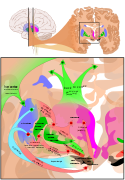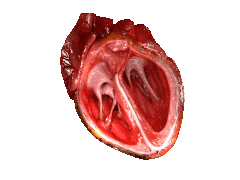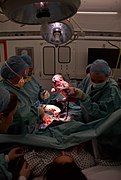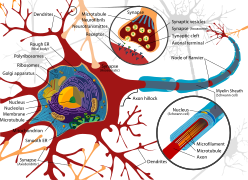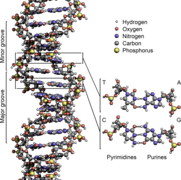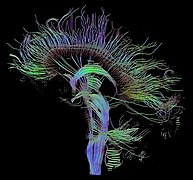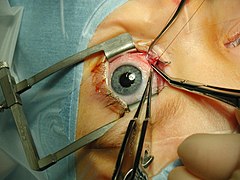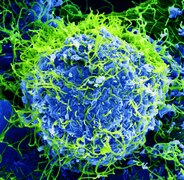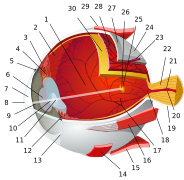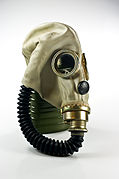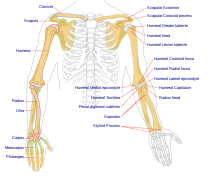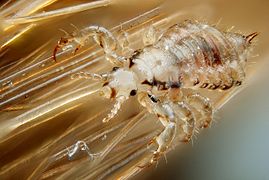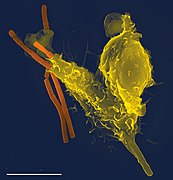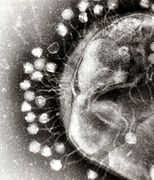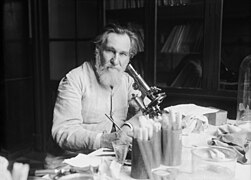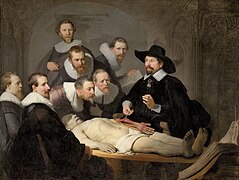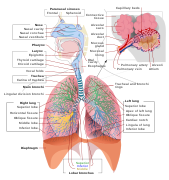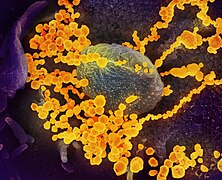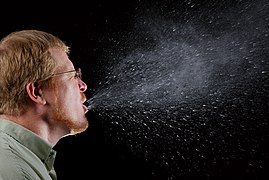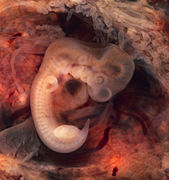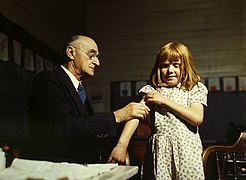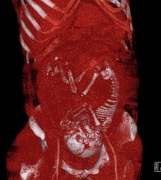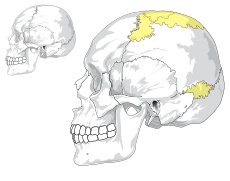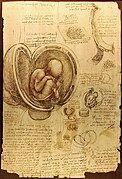Portal:Medicine
The Medicine Portal

Medicine is the science and practice of caring for patients, managing the diagnosis, prognosis, prevention, treatment, palliation of their injury or disease, and promoting their health. Medicine encompasses a variety of health care practices evolved to maintain and restore health by the prevention and treatment of illness. Contemporary medicine applies biomedical sciences, biomedical research, genetics, and medical technology to diagnose, treat, and prevent injury and disease, typically through pharmaceuticals or surgery, but also through therapies as diverse as psychotherapy, external splints and traction, medical devices, biologics, and ionizing radiation, amongst others.
Medicine has been practiced since prehistoric times, and for most of this time it was an art (an area of creativity and skill), frequently having connections to the religious and philosophical beliefs of local culture. For example, a medicine man would apply herbs and say prayers for healing, or an ancient philosopher and physician would apply bloodletting according to the theories of humorism. In recent centuries, since the advent of modern science, most medicine has become a combination of art and science (both basic and applied, under the umbrella of medical science). For example, while stitching technique for sutures is an art learned through practice, knowledge of what happens at the cellular and molecular level in the tissues being stitched arises through science.
Prescientific forms of medicine, now known as traditional medicine or folk medicine, remain commonly used in the absence of scientific medicine and are thus called alternative medicine. Alternative treatments outside of scientific medicine with ethical, safety and efficacy concerns are termed quackery. (Full article...)
-
Lung cancer, also known as lung carcinoma, is a malignant tumor that begins in the lung. Lung cancer is caused by genetic damage to the DNA of cells in the airways, often caused by cigarette smoking or inhaling damaging chemicals. Damaged airway cells gain the ability to multiply unchecked, causing the growth of a tumor. Without treatment, tumors spread throughout the lung, damaging lung function. Eventually lung tumors metastasize, spreading to other parts of the body.
Early lung cancer often has no symptoms and can only be detected by medical imaging. As the cancer progresses, most people experience nonspecific respiratory problems: coughing, shortness of breath, or chest pain. Other symptoms depend on the location and size of the tumor. Those suspected of having lung cancer typically undergo a series of imaging tests to determine the location and extent of any tumors. Definitive diagnosis of lung cancer requires a biopsy of the suspected tumor be examined by a pathologist under a microscope. In addition to recognizing cancerous cells, a pathologist can classify the tumor according to the type of cells it originates from. Around 15% of cases are small-cell lung cancer (SCLC), and the remaining 85% (the non-small-cell lung cancers or NSCLC) are adenocarcinomas, squamous-cell carcinomas, and large-cell carcinomas. After diagnosis, further imaging and biopsies are done to determine the cancer's stage based on how far it has spread. (Full article...) -
Major depressive disorder (MDD), also known as clinical depression, is a mental disorder characterized by at least two weeks of pervasive low mood, low self-esteem, and loss of interest or pleasure in normally enjoyable activities. Introduced by a group of US clinicians in the mid-1970s, the term was adopted by the American Psychiatric Association for this symptom cluster under mood disorders in the 1980 version of the Diagnostic and Statistical Manual of Mental Disorders (DSM-III), and has become widely used since. The disorder causes the second-most years lived with disability, after lower back pain.
The diagnosis of major depressive disorder is based on the person's reported experiences, behavior reported by relatives or friends, and a mental status examination. There is no laboratory test for the disorder, but testing may be done to rule out physical conditions that can cause similar symptoms. The most common time of onset is in a person's 20s, with females affected about twice as often as males. The course of the disorder varies widely, from one episode lasting months to a lifelong disorder with recurrent major depressive episodes. (Full article...) -

β-Hydroxy β-methylbutyric acid (HMB), otherwise known as its conjugate base, β-hydroxy β-methylbutyrate, is a naturally produced substance in humans that is used as a dietary supplement and as an ingredient in certain medical foods that are intended to promote wound healing and provide nutritional support for people with muscle wasting due to cancer or HIV/AIDS. In healthy adults, supplementation with HMB has been shown to increase exercise-induced gains in muscle size, muscle strength, and lean body mass, reduce skeletal muscle damage from exercise, improve aerobic exercise performance, and expedite recovery from exercise. Medical reviews and meta-analyses indicate that HMB supplementation also helps to preserve or increase lean body mass and muscle strength in individuals experiencing age-related muscle loss. HMB produces these effects in part by stimulating the production of proteins and inhibiting the breakdown of proteins in muscle tissue. No adverse effects from long-term use as a dietary supplement in adults have been found.
HMB is sold as a dietary supplement at a cost of about US$30–50 per month when taking 3 grams per day. HMB is also contained in several nutritional products, including certain formulations of Ensure and Juven. HMB is also present in insignificant quantities in certain foods, such as alfalfa, asparagus, avocados, cauliflower, grapefruit, and catfish. (Full article...) -
Dengue fever is a mosquito-borne disease caused by dengue virus, prevalent in tropical and subtropical areas. It is frequently asymptomatic; if symptoms appear they typically begin 3 to 14 days after infection. These may include a high fever, headache, vomiting, muscle and joint pains, and a characteristic skin itching and skin rash. Recovery generally takes two to seven days. In a small proportion of cases, the disease develops into severe dengue (previously known as dengue hemorrhagic fever or dengue shock syndrome) with bleeding, low levels of blood platelets, blood plasma leakage, and dangerously low blood pressure.
Dengue virus has four confirmed serotypes; infection with one type usually gives lifelong immunity to that type, but only short-term immunity to the others. Subsequent infection with a different type increases the risk of severe complications. The symptoms of dengue resemble many other diseases including malaria, influenza, and Zika. Blood tests are available to confirm the diagnosis including detecting viral RNA, or antibodies to the virus. (Full article...) -
A virus is a submicroscopic infectious agent that replicates only inside the living cells of an organism. Viruses infect all life forms, from animals and plants to microorganisms, including bacteria and archaea. Viruses are found in almost every ecosystem on Earth and are the most numerous type of biological entity. Since Dmitri Ivanovsky's 1892 article describing a non-bacterial pathogen infecting tobacco plants and the discovery of the tobacco mosaic virus by Martinus Beijerinck in 1898, more than 11,000 of the millions of virus species have been described in detail. The study of viruses is known as virology, a subspeciality of microbiology.
When infected, a host cell is often forced to rapidly produce thousands of copies of the original virus. When not inside an infected cell or in the process of infecting a cell, viruses exist in the form of independent viral particles, or virions, consisting of (i) genetic material, i.e., long molecules of DNA or RNA that encode the structure of the proteins by which the virus acts; (ii) a protein coat, the capsid, which surrounds and protects the genetic material; and in some cases (iii) an outside envelope of lipids. The shapes of these virus particles range from simple helical and icosahedral forms to more complex structures. Most virus species have virions too small to be seen with an optical microscope and are one-hundredth the size of most bacteria. (Full article...) -
Leeches are segmented parasitic or predatory worms that comprise the subclass Hirudinea within the phylum Annelida. They are closely related to the oligochaetes, which include the earthworm, and like them have soft, muscular segmented bodies that can lengthen and contract. Both groups are hermaphrodites and have a clitellum, but leeches typically differ from the oligochaetes in having suckers at both ends and in having ring markings that do not correspond with their internal segmentation. The body is muscular and relatively solid, and the coelom, the spacious body cavity found in other annelids, is reduced to small channels.
The majority of leeches live in freshwater habitats, while some species can be found in terrestrial or marine environments. The best-known species, such as the medicinal leech, Hirudo medicinalis, are hematophagous, attaching themselves to a host with a sucker and feeding on blood, having first secreted the peptide hirudin to prevent the blood from clotting. The jaws used to pierce the skin are replaced in other species by a proboscis which is pushed into the skin. A minority of leech species are predatory, mostly preying on small invertebrates. (Full article...) -
Everywhere at the End of Time (commonly shortened to EATEOT) is the eleventh recording by the Caretaker, an alias of English electronic musician Leyland Kirby. Released between 2016 and 2019, its six studio albums use degrading loops of sampled ballroom music to portray the progression of Alzheimer's disease. Inspired by the success of An Empty Bliss Beyond This World (2011), Kirby produced Everywhere as his final major work under the alias. The albums were produced in Kraków and released over six-month periods to "give a sense of time passing", with abstract album covers by his friend Ivan Seal. The series drew comparisons to the works of composer William Basinski and electronic musician Burial, while the later stages were influenced by avant-gardist composer John Cage.
The series comprises six hours of music, portraying a range of emotions and characterised by noise throughout. Although the first three stages are similar to An Empty Bliss, the last three depart from Kirby's earlier ambient works. The albums reflect the patient's disorder and death, their feelings, and the phenomenon of terminal lucidity. To promote the series, anonymous visual artist Weirdcore created music videos for the first two stages. At first, concerned about whether the series would seem pretentious, Kirby thought of not creating Everywhere at all, and spent more time producing it than any of his other releases. The album covers received attention from a French art exhibition named after the Caretaker's Everywhere, an Empty Bliss (2019), a compilation of archived songs. (Full article...) -
Race Against Time: Searching for Hope in AIDS-Ravaged Africa is a non-fiction book written by Stephen Lewis for the Massey Lectures. Lewis wrote it in early to mid-2005 and House of Anansi Press released it as a corresponding lecture series began in October 2005. Each of the book's chapters were delivered as a different lecture in a different Canadian city, beginning in Vancouver on October 18 and ending in Toronto on October 28. The speeches were aired on CBC Radio One between November 7 and 11. The author and orator, Stephen Lewis, was at that time the United Nations Special Envoy for HIV/AIDS in Africa and former Canadian ambassador to the United Nations. Although he wrote the book and lectures in his role as a concerned Canadian citizen, his criticism of the United Nations (UN), international organizations, and other diplomats, including naming specific people, was called undiplomatic and led several reviewers to speculate whether he would be removed from his UN position.
In the book and the lectures, Lewis argues that significant changes are required to meet the Millennium Development Goals in Africa by their 2015 deadline. Lewis explains the historical context of Africa since the 1980s, citing a succession of disastrous economic policies by international financial institutions that contributed to, rather than reduced, poverty. He connects the structural adjustment loans, with conditions of limited public spending on health and education infrastructure, to the uncontrolled spread of AIDS and subsequent food shortages as the disease infected much of the working-age population. Lewis also addresses such issues as discrimination against women and primary education for children. To help alleviate problems, he ends with potential solutions which mainly require increased funding by G8 countries to levels beyond what they promise. (Full article...) -
Brigadier Sir Neil Hamilton Fairley, KBE, CStJ, FRACP, FRCP, FRCPE, FRS (15 July 1891 – 19 April 1966) was an Australian physician, medical scientist, and army officer who was instrumental in saving thousands of Allied lives from malaria and other diseases.
A graduate of the University of Melbourne, where he was resident of Ormond College, Fairley joined the Australian Army Medical Corps in 1915. He investigated an epidemic of meningitis that was occurring in Army camps in Australia. While with the 14th General Hospital in Cairo, he investigated schistosomiasis (then known as bilharzia) and developed tests and treatments for the disease. In the inter-war period he became renowned as an expert on tropical medicine. (Full article...) -
Taare Zameen Par (lit. 'Stars on Earth'), also known as Like Stars on Earth in English, is a 2007 Indian Hindi-language psychological drama film produced and directed by Aamir Khan. It stars Khan himself, with Darsheel Safary, Tanay Chheda, Vipin Sharma and Tisca Chopra. It explores the life and imagination of Ishaan (Safary), an artistically gifted 8-year-old boy whose poor academic performance leads his parents to send him to a boarding school, where a new art teacher Nikumbh (Khan) suspects that he is dyslexic and helps him to overcome his reading disorder.
Creative director and writer Amole Gupte developed the idea with his wife Deepa Bhatia, who was the film's editor. Shankar–Ehsaan–Loy composed the score, and Prasoon Joshi wrote the lyrics for many of the songs. Principal photography took place in Mumbai, and in Panchgani's New Era High School, where some of the school's students participated in the filming. (Full article...) -

Major General Rupert Major Downes, CMG, KStJ, VD, FRACS (10 February 1885 – 5 March 1945) was an Australian soldier, surgeon and historian.
The son of British Army officer Major Francis Downes, Downes joined the Army as a trumpeter while he was still at school. He attended the University of Melbourne, graduating with his medical degrees in 1907 and a Doctor of Medicine degree in 1911. He was commissioned as a captain in the Australian Army Medical Corps in 1908, and after the outbreak of the First World War he joined the First Australian Imperial Force (AIF) in 1914 as its youngest lieutenant colonel. He served in the Gallipoli campaign, and was appointed Assistant Director of Medical Services (ADMS) of the newly formed Anzac Mounted Division in 1916, which he combined with the post of ADMS AIF Egypt. In 1917, he became Deputy Director of Medical Services (DDMS) of the Desert Mounted Corps. After the war, he wrote articles on medical aspects of the Sinai and Palestine campaign, and the section on the campaign for the Official History of Australia in the War of 1914–1918. (Full article...) -
Helicobacter pylori, previously known as Campylobacter pylori, is a gram-negative, flagellated, helical bacterium. Mutants can have a rod or curved rod shape, and these are less effective. Its helical body (from which the genus name, Helicobacter, derives) is thought to have evolved in order to penetrate the mucous lining of the stomach, helped by its flagella, and thereby establish infection. The bacterium was first identified as the causal agent of gastric ulcers in 1983 by the Australian doctors Barry Marshall and Robin Warren.
Infection of the stomach with H. pylori is not the cause of illness itself; over half of the global population is infected but most are asymptomatic. Persistent colonization with more virulent strains can induce a number of gastric and extragastric disorders. Gastric disorders due to infection begin with gastritis, inflammation of the stomach lining. When infection is persistent the prolonged inflammation will become chronic gastritis. Initially this will be non-atrophic gastritis, but damage caused to the stomach lining can bring about the change to atrophic gastritis, and the development of ulcers both within the stomach itself or in the duodenum, the nearest part of the intestine. At this stage the risk of developing gastric cancer is high. However, the development of a duodenal ulcer has a lower risk of cancer.Helicobacter pylori is a class 1 carcinogen, and potential cancers include gastric mucosa-associated lymphoid tissue (MALT) lymphomas and gastric cancer. Infection with H. pylori is responsible for around 89 per cent of all gastric cancers, and is linked to the development of 5.5 per cent of all cases of cancer worldwide. H. pylori is the only bacterium known to cause cancer. (Full article...) -

Young people with polio receiving physiotherapy in the 1950s
The social history of viruses describes the influence of viruses and viral infections on human history. Epidemics caused by viruses began when human behaviour changed during the Neolithic period, around 12,000 years ago, when humans developed more densely populated agricultural communities. This allowed viruses to spread rapidly and subsequently to become endemic. Viruses of plants and livestock also increased, and as humans became dependent on agriculture and farming, diseases such as potyviruses of potatoes and rinderpest of cattle had devastating consequences.
Smallpox and measles viruses are among the oldest that infect humans. Having evolved from viruses that infected other animals, they first appeared in humans in Europe and North Africa thousands of years ago. The viruses were later carried to the New World by Europeans during the time of the Spanish Conquests, but the indigenous people had no natural resistance to the viruses and millions of them died during epidemics. Influenza pandemics have been recorded since 1580, and they have occurred with increasing frequency in subsequent centuries. The pandemic of 1918–19, in which 40–50 million died in less than a year, was one of the most devastating in history. (Full article...) -
Cholangiocarcinoma, also known as bile duct cancer, is a type of cancer that forms in the bile ducts. Symptoms of cholangiocarcinoma may include abdominal pain, yellowish skin, weight loss, generalized itching, and fever. Light colored stool or dark urine may also occur. Other biliary tract cancers include gallbladder cancer and cancer of the ampulla of Vater.
Risk factors for cholangiocarcinoma include primary sclerosing cholangitis (an inflammatory disease of the bile ducts), ulcerative colitis, cirrhosis, hepatitis C, hepatitis B, infection with certain liver flukes, and some congenital liver malformations. However, most people have no identifiable risk factors. The diagnosis is suspected based on a combination of blood tests, medical imaging, endoscopy, and sometimes surgical exploration. The disease is confirmed by examination of cells from the tumor under a microscope. It is typically an adenocarcinoma (a cancer that forms glands or secretes mucin). (Full article...) -
Genetics is the study of genes, genetic variation, and heredity in organisms. It is an important branch in biology because heredity is vital to organisms' evolution. Gregor Mendel, a Moravian Augustinian friar working in the 19th century in Brno, was the first to study genetics scientifically. Mendel studied "trait inheritance", patterns in the way traits are handed down from parents to offspring over time. He observed that organisms (pea plants) inherit traits by way of discrete "units of inheritance". This term, still used today, is a somewhat ambiguous definition of what is referred to as a gene.
Trait inheritance and molecular inheritance mechanisms of genes are still primary principles of genetics in the 21st century, but modern genetics has expanded to study the function and behavior of genes. Gene structure and function, variation, and distribution are studied within the context of the cell, the organism (e.g. dominance), and within the context of a population. Genetics has given rise to a number of subfields, including molecular genetics, epigenetics, and population genetics. Organisms studied within the broad field span the domains of life (archaea, bacteria, and eukarya). (Full article...)
Selected image –

Photo credit: Centers for Disease Control / C. Goldsmith
WikiProject

Get involved by joining WikiProject Medicine. We discuss collaborations and all manner of issues on our talk page.
Related portals
-

Sir John Struthers MD FRCSE FRSE (21 February 1823 – 24 February 1899) was the first Regius Professor of Anatomy at the University of Aberdeen. He was a dynamic teacher and administrator, transforming the status of the institutions in which he worked. He was equally passionate about anatomy, enthusiastically seeking out and dissecting the largest and finest specimens, including whales, and troubling his colleagues with his single-minded quest for money and space for his collection. His collection was donated to Surgeon's Hall in Edinburgh.
Among scientists, he is perhaps best known for his work on the ligament which bears his name. His work on the rare and vestigial ligament of Struthers came to the attention of Charles Darwin, who used it in his Descent of Man to help argue the case that man and other mammals shared a common ancestor ; or "community of descent," as Darwin expressed it. (Full article...) -

Folate, also known as vitamin B9 and folacin, is one of the B vitamins. Manufactured folic acid, which is converted into folate by the body, is used as a dietary supplement and in food fortification as it is more stable during processing and storage. Folate is required for the body to make DNA and RNA and metabolise amino acids necessary for cell division and maturation of blood cells. As the human body cannot make folate, it is required in the diet, making it an essential nutrient. It occurs naturally in many foods. The recommended adult daily intake of folate in the U.S. is 400 micrograms from foods or dietary supplements.
Folate in the form of folic acid is used to treat anemia caused by folate deficiency. Folic acid is also used as a supplement by women during pregnancy to reduce the risk of neural tube defects (NTDs) in the baby. Low levels in early pregnancy are believed to be the cause of more than half of babies born with NTDs. More than 80 countries use either mandatory or voluntary fortification of certain foods with folic acid as a measure to decrease the rate of NTDs. Long-term supplementation with relatively large amounts of folic acid is associated with a small reduction in the risk of stroke and an increased risk of prostate cancer. There are concerns that large amounts of supplemental folic acid can hide vitamin B12 deficiency. (Full article...) -
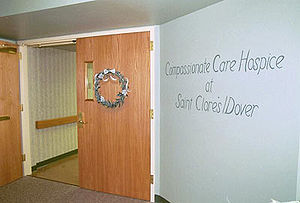
Exterior of an inpatient hospice unit
In the United States, hospice care is a type and philosophy of end-of-life care which focuses on the palliation of a terminally ill patient's symptoms. These symptoms can be physical, emotional, spiritual or social in nature. The concept of hospice as a place to treat the incurably ill has been evolving since the 11th century. Hospice care was introduced to the United States in the 1970s in response to the work of Cicely Saunders in the United Kingdom. This part of health care has expanded as people face a variety of issues with terminal illness. In the United States, it is distinguished by extensive use of volunteers and a greater emphasis on the patient's psychological needs in coming to terms with dying.
Under hospice, medical and social services are supplied to patients and their families by an interdisciplinary team of professional providers and volunteers, who take a patient-directed approach to managing illness. Generally, treatment is not diagnostic or curative, although the patient may choose some treatment options intended to prolong life, such as CPR. Most hospice services are covered by Medicare or other providers, and many hospices can provide access to charitable resources for patients lacking such coverage. (Full article...) -

Colonel Sir Edward Ford, OBE, FRACP, FRCP (15 April 1902 – 27 August 1986) was an Australian soldier, academic and physician. He played an important role in the anti-malaria campaign in the South West Pacific Area during the Second World War, and in preventative medicine in Australia after the war, but is best known for his Bibliography of Australian Medicine.
After the war, Ford wrote a thesis on malaria control in the South West Pacific, for which he was awarded his Doctor of Medicine (MD) degree by the University of Melbourne in 1946. He became Director of the School of Public Health and Tropical Medicine at the University of Sydney in 1946, and Professor of Preventive Medicine in 1947, concurrently holding these two positions until his 1968 retirement. (Full article...) -

Vitamin A is a fat-soluble vitamin, hence an essential nutrient. The term "vitamin A" encompasses a group of chemically related organic compounds that includes retinol, retinal (also known as retinaldehyde), retinoic acid, and several provitamin (precursor) carotenoids, most notably beta-carotene. Vitamin A has multiple functions: essential in embryo development for growth, maintaining the immune system, and healthy vision, where it combines with the protein opsin to form rhodopsin – the light-absorbing molecule necessary for both low-light (scotopic vision) and color vision.
Vitamin A occurs as two principal forms in foods: A) retinol, found in animal-sourced foods, either as retinol or bound to a fatty acid to become a retinyl ester, and B) the carotenoids alpha-carotene, β-carotene, gamma-carotene, and the xanthophyll beta-cryptoxanthin (all of which contain β-ionone rings) that function as provitamin A in herbivore and omnivore animals which possess the enzymes that cleave and convert provitamin carotenoids to retinal and then to retinol. Some carnivore species lack this enzyme. The other carotenoids have no vitamin activity. (Full article...) -

Jennie Smillie Robertson (February 10, 1878 – February 26, 1981), known throughout her career as Jennie Smillie, was the first Canadian female surgeon and also performed the country's first major gynecological surgery. Born to farmers, she worked as a teacher to afford tuition for medical school before enrolling at the Ontario Medical College for Women which merged into the University of Toronto medical school during her time there. Due to a lack of options in Toronto, she completed her training in the United States. In 1911, she helped re-found her alma mater as today's Women's College Hospital after no Toronto hospital would let her perform surgery. She died at age 103. (Full article...) -
The Corrupted Blood incident (also known as the World of Warcraft pandemic) took place between September 13 and October 8, 2005, in World of Warcraft, a massively multiplayer online role-playing game (MMORPG) developed by Blizzard Entertainment. When participating in a certain boss battle at the end of a raid, player characters would become infected with a debuff that was transmitted between characters in close proximity. While developers intended to keep the effects of the debuff within this boss's game region, a programming oversight soon led to an in-game pandemic throughout the fictional world of Azeroth.
World of Warcraft introduced the game region of Zul'Gurub on September 13. The boss of the region, Hakkar the Soulflayer, cast the debuff Corrupted Blood on raid participants, which expired when players defeated Hakkar. Corrupted Blood soon spread beyond Zul'Gurub through players by deactivating their infected animal companions, who when reactivated in densely populated non-combat zones, still carried the debuff, becoming disease vectors, while non-player characters became asymptomatic carriers. Player reactions to the Corrupted Blood pandemic varied: some provided aid by healing players or warning them of outbreak zones, while griefers intentionally contracted the debuff to spread it across the game world. After several failed hotfixes, Blizzard ended the pandemic by performing a hard reset, and a later patch prevented companions from contracting Corrupted Blood entirely. (Full article...) -
Croup, also known as laryngotracheobronchitis, is a type of respiratory infection that is usually caused by a virus. The infection leads to swelling inside the trachea, which interferes with normal breathing and produces the classic symptoms of "barking/brassy" cough, inspiratory stridor and a hoarse voice. Fever and runny nose may also be present. These symptoms may be mild, moderate, or severe. Often it starts or is worse at night and normally lasts one to two days.
Croup can be caused by a number of viruses including parainfluenza and influenza virus. Rarely is it due to a bacterial infection. Croup is typically diagnosed based on signs and symptoms after potentially more severe causes, such as epiglottitis or an airway foreign body, have been ruled out. Further investigations, such as blood tests, X-rays and cultures, are usually not needed. (Full article...) -
Hepatitis C is an infectious disease caused by the hepatitis C virus (HCV) that primarily affects the liver; it is a type of viral hepatitis. During the initial infection period, people often have mild or no symptoms. Early symptoms can include fever, dark urine, abdominal pain, and yellow tinged skin. The virus persists in the liver, becoming chronic, in about 70% of those initially infected. Early on, chronic infection typically has no symptoms. Over many years however, it often leads to liver disease and occasionally cirrhosis. In some cases, those with cirrhosis will develop serious complications such as liver failure, liver cancer, or dilated blood vessels in the esophagus and stomach.
HCV is spread primarily by blood-to-blood contact associated with injection drug use, poorly sterilized medical equipment, needlestick injuries in healthcare, and transfusions. In regions where blood screening has been implemented, the risk of contracting HCV from a transfusion has dropped substantially to less than one per two million. HCV may also be spread from an infected mother to her baby during birth. It is not spread through breast milk, food, water or casual contact such as hugging, kissing and sharing food or drinks with an infected person. It is one of five known hepatitis viruses: A, B, C, D, and E.
Diagnosis is by blood testing to look for either antibodies to the virus or viral RNA. In the United States, screening for HCV infection is recommended in all adults age 18 to 79 years old.
There is no vaccine against hepatitis C. Prevention includes harm reduction efforts among people who inject drugs, testing donated blood, and treatment of people with chronic infection. Chronic infection can be cured more than 95% of the time with antiviral medications such as sofosbuvir or simeprevir. Peginterferon and ribavirin were earlier generation treatments that proved successful in <50% of cases and caused greater side effects. While access to the newer treatments was expensive, by 2022 prices had dropped dramatically in many countries (primarily low-income and lower-middle-income countries) due to the introduction of generic versions of medicines. Those who develop cirrhosis or liver cancer may require a liver transplant. Hepatitis C is one of the leading reasons for liver transplantation, though the virus usually recurs after transplantation. (Full article...) -
Idiopathic intracranial hypertension (IIH), previously known as pseudotumor cerebri and benign intracranial hypertension, is a condition characterized by increased intracranial pressure (pressure around the brain) without a detectable cause. The main symptoms are headache, vision problems, ringing in the ears, and shoulder pain. Complications may include vision loss.
This condition is idiopathic, meaning there is no known cause. Risk factors include being overweight or a recent increase in weight. Tetracycline may also trigger the condition. The diagnosis is based on symptoms and a high opening pressure found during a lumbar puncture with no specific cause found on a brain scan. (Full article...) -
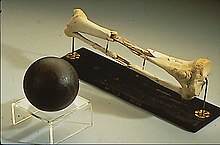
Sickles's leg bones on display
The amputated right lower leg of Union Army general Daniel Sickles, lost after a cannonball wound suffered at the Battle of Gettysburg on July 2, 1863, is displayed at the National Museum of Health and Medicine.
Sickles was a former New York politician who entered the army after the outbreak of the American Civil War in 1861. After originally commanding the Excelsior Brigade, Sickles was promoted to major general in 1862 and later commanded the III Corps at the battles of Chancellorsville and Gettysburg. At Gettysburg, Sickles moved the III Corps forward from his assigned position, and it was shattered by a Confederate attack. During the fighting, he was struck in the leg by a solid shot; the wound later required amputation above the knee. After the amputation, the limb was donated to the Army Medical Museum (now the National Museum of Health and Medicine), where it was used as a teaching example of battlefield trauma. Sickles sometimes visited the limb afterwards, and it remains a popular attraction at the museum. (Full article...) -
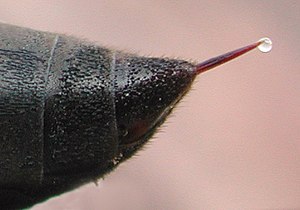
Wasp stinger with a droplet of venom
Venom or zootoxin is a type of toxin produced by an animal that is actively delivered through a wound by means of a bite, sting, or similar action. The toxin is delivered through a specially evolved venom apparatus, such as fangs or a stinger, in a process called envenomation. Venom is often distinguished from poison, which is a toxin that is passively delivered by being ingested, inhaled, or absorbed through the skin, and toxungen, which is actively transferred to the external surface of another animal via a physical delivery mechanism.
Venom has evolved in terrestrial and marine environments and in a wide variety of animals: both predators and prey, and both vertebrates and invertebrates. Venoms kill through the action of at least four major classes of toxin, namely necrotoxins and cytotoxins, which kill cells; neurotoxins, which affect nervous systems; myotoxins, which damage muscles; and haemotoxins, which disrupt blood clotting. Venomous animals cause tens of thousands of human deaths per year. (Full article...) -
A dental implant (also known as an endosseous implant or fixture) is a prosthesis that interfaces with the bone of the jaw or skull to support a dental prosthesis such as a crown, bridge, denture, or facial prosthesis or to act as an orthodontic anchor. The basis for modern dental implants is a biological process called osseointegration, in which materials such as titanium or zirconia form an intimate bond to the bone. The implant fixture is first placed so that it is likely to osseointegrate, then a dental prosthetic is added. A variable amount of healing time is required for osseointegration before either the dental prosthetic (a tooth, bridge, or denture) is attached to the implant or an abutment is placed which will hold a dental prosthetic or crown.
Success or failure of implants depends primarily on the thickness and health of the bone and gingival tissues that surround the implant, but also on the health of the person receiving the treatment and drugs which affect the chances of osseointegration. The amount of stress that will be put on the implant and fixture during normal function is also evaluated. Planning the position and number of implants is key to the long-term health of the prosthetic since biomechanical forces created during chewing can be significant. The position of implants is determined by the position and angle of adjacent teeth, by lab simulations or by using computed tomography with CAD/CAM simulations and surgical guides called stents. The prerequisites for long-term success of osseointegrated dental implants are healthy bone and gingiva. Since both can atrophy after tooth extraction, pre-prosthetic procedures such as sinus lifts or gingival grafts are sometimes required to recreate ideal bone and gingiva. (Full article...) -
The 1918–1920 flu pandemic, also known as the Great Influenza epidemic or by the common misnomer Spanish flu, was an exceptionally deadly global influenza pandemic caused by the H1N1 subtype of the influenza A virus. The earliest documented case was March 1918 in the state of Kansas in the United States, with further cases recorded in France, Germany and the United Kingdom in April. Two years later, nearly a third of the global population, or an estimated 500 million people, had been infected in four successive waves. Estimates of deaths range from 17 million to 50 million, and possibly as high as 100 million, making it one of the deadliest pandemics in history.
The pandemic broke out near the end of World War I, when wartime censors in the belligerent countries suppressed bad news to maintain morale, but newspapers freely reported the outbreak in neutral Spain, creating a false impression of Spain as the epicenter and leading to the "Spanish flu" misnomer. Limited historical epidemiological data make the pandemic's geographic origin indeterminate, with competing hypotheses on the initial spread. (Full article...) -
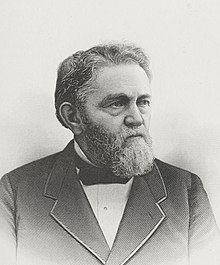
William Heath Byford (March 20, 1817 – May 21, 1890) was an American physician, surgeon, gynecologist and advocate of medical education for women who was most notable for founding the Chicago Medical College and Woman's Medical College of Chicago.
Byford was born in Eaton, Ohio. After graduating from the Medical College of Ohio, he served on multiple chairs at the Evansville Medical College and Rush Medical College. In 1859, after he quit from Rush, he founded the Chicago Medical College along with his colleagues, where he also received the chair of obstetrics. (Full article...)
Did you know –
- ... that lagophthalmos is the inability to close the eyelids?
- ... that Beck's triad of arterial hypotension, raised jugular venous pressure and muffled heart sounds is pathognomonic of cardiac tamponade?
- ... that dark chocolate contains the highest antioxidant content of any food? It contains phosphorus, magnesium, iron and potassium. In addition, dark chocolate can lower blood pressure.
General images –
-
Patient, Surrey County Lunatic Asylum, c. 1850–58. The asylum population in England and Wales rose from 1,027 in 1827 to 74,004 in 1900. (from History of medicine)
-
A doctor checks a patient's pulse in Meiji-era Japan. (from History of medicine)
-
Yarrow, a medicinal plant found in human-occupied caves in the Upper Palaeolithic period. (from History of medicine)
-
An American billing clerk preparing a detailed invoice. (1992) (from Medical billing)
-
18th-century medical remedies collected by a British Gentry family (from History of medicine)
-
A 12th-century manuscript of the Hippocratic Oath in Greek, one of the most famous aspects of classical medicine that carried into later eras (from History of medicine)
-
Taoist symbol of Yin and Yang (from Medical ethics)
-
Primary care may be provided in community health centers. (from Health care)
-
Curandera performing a limpieza in Cuenca, Ecuador (from Traditional medicine)
-
Charite in Berlin (from History of medicine)
-
A cochlear implant is a common kind of neural prosthesis, a device replacing part of the human nervous system. (from History of medicine)
-
Depiction of smallpox in Franciscan Bernardino de Sahagún's history of the conquest of Mexico, Book XII of the Florentine Codex, from the defeated Aztecs' point of view (from History of medicine)
-
Total healthcare cost per person. Public and private spending. US dollars PPP. For example: $6,319 for Canada in 2022. $12,555 for the US in 2022. (from Health care)
-
Statue of Robert Koch, father of medical bacteriology, at Robert-Koch-Platz (Robert Koch square) in Berlin (from History of medicine)
-
A cuneiform terracotta tablet describing a medicinal recipe for poisoning (c. 18th century BCE). Discovered in Nippur, Iraq.
-
Medical personnel place sterilized covers on the arms of the daVinci Xi surgical system, a minimally-invasive robotic surgery system, at the William Beaumont Army Medical Center. (from History of medicine)
-
healthcare expenditure in Japan by age group (from Health insurance)
-
Botánicas such as this one in Jamaica Plain, Boston, cater to the Latino community and sell folk medicine alongside statues of saints, candles decorated with prayers, lucky bamboo, and other items. (from Traditional medicine)
-
The Quaker-run York Retreat, founded in 1796, gained international prominence as a centre for moral treatment and a model of asylum reform following the publication of Samuel Tuke's Description of the Retreat (1813). (from History of medicine)
-
Infographic showing how healthcare data flows within the billing process (from Medical billing)
-
A Neo-Assyrian cuneiform tablet fragment describing medical text (c. 9th to 7th century BCE). (from History of medicine)
-
The emergency room is often a frontline venue for the delivery of primary medical care. (from Health care)
-
Emil Kraepelin (1856–1926), the founder of modern scientific psychiatry, psychopharmacology and psychiatric genetics. (from History of medicine)
-
Sketch of Muslim physician Muhammad ibn Zakariya al-Razi (from History of medicine)
-
Medicine during the First World War - Medical Transport. (from History of medicine)
-
Life expectancy vs healthcare spending of rich OECD countries. US average of $10,447 in 2018. (from Health care)
-
Jackson Memorial Hospital in Miami, the primary teaching hospital of the University of Miami's Miller School of Medicine and the largest hospital in the United States with 1,547 beds (from Health care)
-
American combat surgery during the Pacific War, 1943 (from History of medicine)
-
Galen (129–216 CE), known for his wide insights into anatomy. (from History of medicine)
-
Ethical prayer for medical wisdom by Dr Edmond Fernandes (from Medical ethics)
-
Hippocrates (c. 460–370 BCE). Known as the "father of medicine". (from History of medicine)
-
Health Expenditure per capita (in PPP-adjusted US$) among several OECD member nations. Data source: OECD's iLibrary (from Health insurance)
-
The Edwin Smith Surgical Papyrus, written in the 17th century BCE, contains the earliest recorded reference to the brain. New York Academy of Medicine. (from History of medicine)
-
"Diagram of the causes of mortality in the army in the East" by Florence Nightingale. (from History of medicine)
-
The plinthios brochos as described by Greek physician Heraklas, a sling for binding a fractured jaw. These writings were preserved in one of Oribasius' collections. (from History of medicine)
-
A Ukrainian monument to the HIV pandemic. (from History of medicine)
-
Life Expectancy of the total population at birth among several OECD member nations. Data source: OECD's iLibrary (from Health insurance)
-
Guy's Hospital in 1820 (from History of medicine)
-
The numbers of Americans lacking health insurance and the uninsured rate from 1987 to 2008 (from Health insurance)
-
Magical stela or cippus of Horus inscribed with healing encantations (c. 332 to 280 BCE). (from History of medicine)
-
Most countries have seen a tremendous increase in life expectancy since 1945. However, in southern Africa, the HIV epidemic beginning around 1990 has eroded national health. (from History of medicine)
-
National Hospital for Neurology and Neurosurgery in London, United Kingdom is a specialist neurological hospital. (from Health care)
-
Health spending by country. Percent of GDP (Gross domestic product). For example: 11.2% for Canada in 2022. 16.6% for the United States in 2022. (from Health care)
-
AMA Code of Medical Ethics (from Medical ethics)
-
Mandrake (written 'ΜΑΝΔΡΑΓΟΡΑ' in Greek capitals). Naples Dioscurides, 7th century (from History of medicine)
-
Mexico City epidemic of 1737, with elites calling on the Virgin of Guadalupe (from History of medicine)
-
COVID-19 swab testing in Rwanda (2021). (from History of medicine)
-
Seven named physicians and botanists of the Classical world from Vienna Dioscurides. Clockwise from top center: Galen, Dioscorides, Nicander, Rufus of Ephesus, Andreas of Carystus, Apollonius Mus or of Pergamon, Crateuas (from History of medicine)
-
Global concentrations of health care resources, as depicted by the number of physicians per 10,000 individuals, by country. Data is sourced from a World Health Statistics 2010, a WHO report.[needs update] (from Health care)
-
Smallpox vaccination in Niger, 1969. A decade later, this was the first infectious disease to be eradicated. (from History of medicine)
-
"More Doctors Smoke Camels than Any Other Cigarette" advertisement for Camel cigarettes in the 1940s (from Medical ethics)
-
Zhang Zhongjing – a Chinese pharmacologist, physician, inventor, and writer of the Eastern Han dynasty. (from History of medicine)
-
Sometimes traditional medicines include parts of endangered species, such as the slow loris in Southeast Asia. (from Traditional medicine)
More Did you know (auto generated)

- ... that fourteenth-century Buddhist monk Tuệ Tĩnh is referred to as a founding father of traditional Vietnamese medicine?
- ... that James A. Merriman was the only Black graduate from Rush Medical College in 1902 and the first African-American physician to practice medicine in Portland?
- ... that Constance Fozzard was told during her surgical training that women with children could not become consultants?
- ... that a lack of screening for pregnant women with syphilis in sub-Saharan Africa is associated with increased infant mortality?
- ... that the Anglo-Saxons may have used a mixture of garlic, another Allium, wine, and bovine bile as an eye medicine?
- ... that Tang Zonghai was one of the first advocates for the integration of Chinese and Western medicine?
Topics
Categories
Recognized content
Associated Wikimedia
The following Wikimedia Foundation sister projects provide more on this subject:
-
Commons
Free media repository -
Wikibooks
Free textbooks and manuals -
Wikidata
Free knowledge base -
Wikinews
Free-content news -
Wikiquote
Collection of quotations -
Wikisource
Free-content library -
Wikiversity
Free learning tools -
Wiktionary
Dictionary and thesaurus



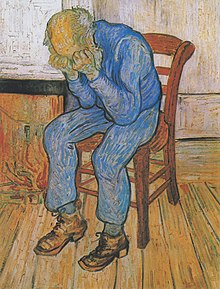

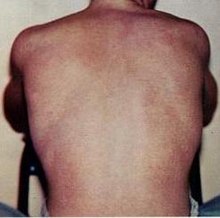
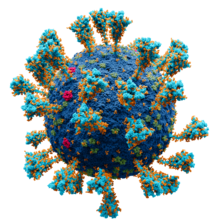



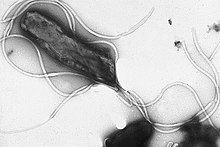









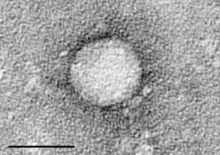
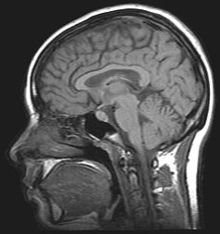



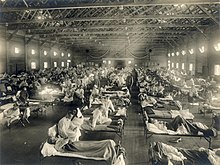






















































![Image 55Global concentrations of health care resources, as depicted by the number of physicians per 10,000 individuals, by country. Data is sourced from a World Health Statistics 2010, a WHO report.[needs update] (from Health care)](http://upload.wikimedia.org/wikipedia/commons/thumb/1/1f/Global_physician_density_map_-_WHO_2010.png/120px-Global_physician_density_map_-_WHO_2010.png)











